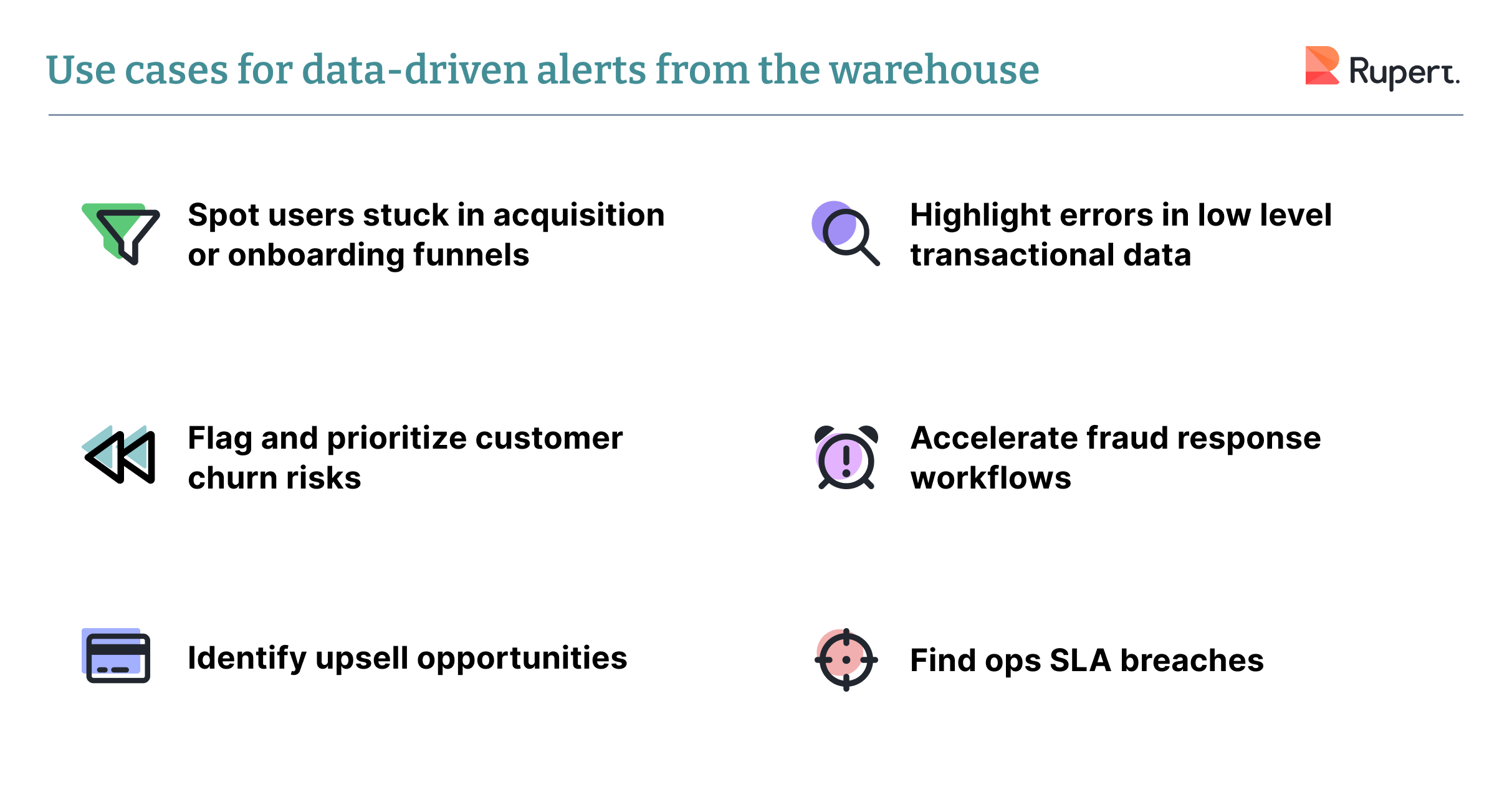For a long time, alerting on data has been a capability reserved for technical teams and use cases. Observability tools like Datadog, New Relic, or Elastic come to mind.
There’s no reason data teams and business use cases should be left out anymore. And there's certainly not a lack of data. Business today create and interact with a huge volume and variety of data.
But the status quo for alerting on business data is a mish-mash of tools and features that don’t actually get the job done.
Across BI, operational tools (+ rETL), anomaly detection tools, or homegrown solutions, alerting capabilities are too narrow, limited, or hard to use. What are the specific issues?
They don’t take full advantage of warehouse data gravity or support anything close to real-time alerting–so they’re not making good use of the large investments data teams have made in pipelines, transformations, and models.
And, more simply, they don’t let analysts create truly custom alerts.
So data teams struggle mightily to create impactful alerts that help stakeholders capitalize on issues or opportunities in their data.
That’s why Rupert is enabling analysts to create alerts directly on top of their data warehouse, first with support for Snowflake and BigQuery.
Any table or view in your data warehouse is accessible from Rupert. Create alerts that...

Whether it’s growing revenue or running more efficiently, the business use cases are compelling. Plus, data teams have already made those big infrastructure investments.
It’s time they had an efficient solution to push that actionable data directly to stakeholders, and get maximum value from their data stack.
Impactful data-driven alerts: the missing piece
Existing alternatives for creating alerts all have limitations that hold data analysts back.
BI Platforms
BI platforms are the right place for exploratory analysis by business users. But these platforms don't let analysts create alerts that cover real world scenarios. Options for trigger criteria are very limited, as is the ability to customize alert messages. Most BI alerts end up generic, noisy, or both. Recipients don’t get the actionable data they need.
Homegrown alerting solutions
For companies with engineering resources to spare and highly specialized use cases, a homegrown, custom alerting solution is attractive. Real money can hit the bottom line if actionable data is pushed to the right stakeholders at the right times.
But most use cases aren’t so unique and who has engineers to spare? So DIY alerting solutions wind up brittle and duct-taped together, delivering a poor user experience to alert creators and recipients. More band aid than solution.
The long tail
Alerts from operational tools are great in theory—already embedded into functional workflows!—but costly rETL is required first. And what if your use case isn’t a fit for the rigid data model or the specific alert workflow prescribed by the tool?
Cost and flexibility issues also hamstring anomaly detection tools. They rack up big data warehouse bills and don’t give analysts the control to avoid creating noisy alerts.
Instead, analysts can now use Rupert to create custom alerts directly from their data in Snowflake or BigQuery.
Create alerts with more flexibility and control
Rupert gives analysts control and flexibility in alert creation that the alternatives can’t. Here’s how we do it:
- Source: Data warehouse or BI. The warehouse unlocks many more possibilities, but you choose what’s right based on your use case and where the relevant business logic lives
- Asset: Start from a warehouse table, SQL query, or BI chart.
- Trigger conditions: Complex functions without code (like moving averages and period over period comparisons), anomaly detection, support for combining multiple conditions, new rows in table–our extensive trigger library has you covered
- Recipients: Send the right alerts to the right people, including external audiences. Mix and match Slack channels, Slack DMs, or email. Save custom groups in Rupert for easy re-use. Quickly personalize alert contents at scale with point-and-click user attribute filtering, even on the DWH.
- Message contents: You get to decide what text and data belong in your alert message. You’re not limited to the auto-generated jargon or static text typical of most alerts. Inject dynamic data (not just the trigger metric) into the message.
- Noise control: With Rupert, you’re not just firing off alerts into the abyss. Every alert has noise reduction features and detailed engagement tracking, so alert creators can tweak or turn off alerts that aren’t having an impact.
Adding a data warehouse connection capability to our no-code alert builder is about more than Rupert having a longer list of integrations. The warehouse has become the best “live representation” of what’s happening within a business. It’s effectively the harddrive of modern business. So it’s the natural source for pushing timely, actionable data to stakeholders.
A few more specific benefits of the Rupert + data warehouse combination:
- Support for a broader range of real-world alert scenarios means stakeholders can be more data-driven
- An efficient alert creation process with no extra steps lets small data teams support more internal customers
- Near-real time monitoring of data in the warehouse means finding and surfacing issues or opportunities in data sooner
Ready to test drive Rupert for yourself and experience the power of alerts from your data warehouse? Request access and join our data warehouse beta program today.



